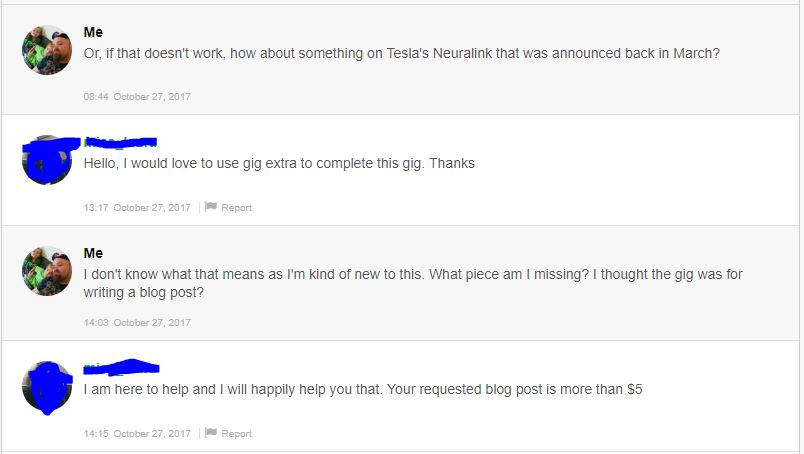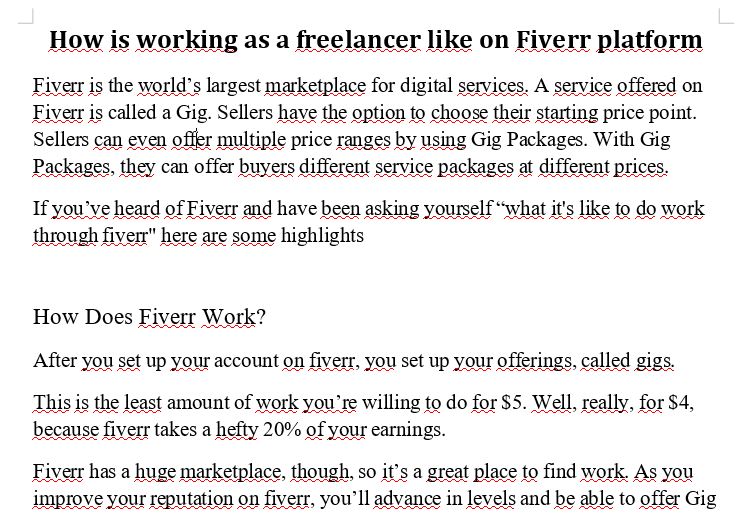In the first post on Freelance Marketplaces, I wrote little about how the buying and selling process work on Fiverr and if you should reasonably expect good, quality work for five dollars (spoiler: no). Fiverr is a very robust platform, but with the addition of the gig extras and custom orders paired with the sheer number of people within each space who fall into the categories below, you really can’t get much for 5 bucks anymore. Honestly, I think you’re going to be hard pressed to find a decent delivery for anything under $25. This may be sustainable for bigger blog sites, but here at Big Guy on Stuff, we’re still lack the amount of traffic to justify this. Today I’m going to talk about the three biggest issues I ran into during my journeys through Fiverr land — The Inept Seller, The Extras Pushing Seller, and the “Plagiarisms R Us” Seller.
The Inept Seller
I love bananas
There are a lot of sellers on Fiverr who aren’t anywhere near an expert in the field for which they are offering work. While working with some of the folks offering blog writing services, I never received anything that was 100% ready for posting. I accepted the fact that everyone writes differently, and that I would have to work with the posts a little to make them fit our style here at BGoS. However, I did not expect to have to spend as so much time doctoring up an article that I would have been better off just writing it myself. The “Inept Seller” on Fiverr is delivering unique work (at least the best I can tell he is), but the content is riddled with so many grammatical errors that a 100 monkeys on typewriters could have produced better results.
The Proof is in the (Banana) Pudding
Some times it’s really just that these folks don’t take any time at all to proof read, but sometimes you can tell that they just have no idea how to put a sentence together correctly (an English one at least). Some of this is due to a lot of the sellers being from other countries. I’m OK with this as I know a huge share of the market is in the US, but if you are going to write for a blog in a different language or culture, you should spend the time to learn how to do it properly. I often ran across little gems like the one below:

I get that this is an easy mistake, but if you are doing a job for someone else, the very least you can do is proof read your deliverable at least once. Things like this would easily be caught. Below you can see where someone may not know her audience well enough. I’m not sure if I’ve every heard of anyone “receiving a courier” here in the US before. I hate to use this one as an example, because this came from a post that actually was one of the better deliverables that I received from Fiverr. I actually left it in the blog post as well because it was interesting, but you can see how this could get out of hand.

The Extras Pushing Seller
On to our next evil seller category, “The Extras Pushing Seller”. This seller posts services that are competitively priced near the 5 dollar mark as a basic package. However, when you attempt to order this work, the seller will keep asking you for details. Eventually they may say they cannot help you unless you take advantage of some of the extra offerings or build a customized order. The screenshots below show one example of this. I often just pick the five dollar package to see what the seller actually produces, then if I think I can use it as a blog post, I will go back and purchase something that costs a little more. In this exchange, the seller said she could write about any topic, but every time I offered one up, it wasn’t good enough. She then tried to push extra purchases on me.


I know I shouldn’t expect a lot of research for a 5 dollar blog post, but I wasn’t asking for a term paper. I was only asking for a few hundred words as an overview to some topics.
The “Plagiarisms R Us” Seller
And now we get to what I believe is the worst offender in the blog article space — “The ‘Plagiarisms R Us’ Seller”. These sellers always seem to mention in their gig descriptions that they will offer a deliverable that is 100% unique. They also usually claim that it will pass CopyScape (a widely used plagiarism detection tool). However, when you do receive the finished blog post, you find out that it is not unique work. Using a few free tools out on the internet, you will find that the article was directly copied from one or more sources. This evil seller is so evil, that I had to break it down into two categories, “The Blatant Plagiarizer” and “The Sneaky Plagiarizer”.
The Blatant Plagiarizer
The Blatant Plagiarizer doesn’t care that he is plagiarizing content, and furthermore, doesn’t think you will check his work at all to be sure that it is unique. You receive a finished blog article that is well written, and you think, “This is great! I’m going to meet my deadline with little extra work this time!” Then you go to your favorite plagiarism checker and find out that there is not one unique phrase in the content. Your night as a blogger just got longer if you need content for the next day. Have fun with that ( I know i did)!
The Sneaky Plagiarizer
The Sneaky Plagiarizer is the most despicable villain of them all. This guy knows he’s sending you plagiarized content, but he tries to hide it!
You sit down at your computer to go over the deliverable you received for your next blog post. The article is well written. Not getting too excited yet after your last experience, you go to your favorite plagiarism checker (or multiple). You paste in the content. After the tool churns on the document a little bit, you finally get the answer:

Nothing to see here!
“Oh, perfect! This will Work!” you think to yourself. Then something hits you. After using the plagiarism tools enough, you will find that it almost NEVER gives 100% “no plagiarism detected”. It’s almost impossible as there is usually something on the internet with a sentence or two similar to your content. Feeling that something wasn’t right, you take another look at your newly acquired blog post. You noticed something before but chocked it up to crazy text editor behavior. Looking at the screenshot below, you will see that the editor is flagging almost every word as misspelled, but looking at it, you can clearly see it is not. Stupid text editor!

After seeing the 100% no plagiarism detected result, you start wondering about this a little more. You find out that the characters in this document, while appearing to be English characters, actually are not at all. At this point, you’re pretty sure it’s plagiarized, but you want to figure out what’s going on. If you’re like this blogger, you take a screenshot of the work and use an online OCR (Optical Character Recognition) tool to convert the picture into text. Once you do this, you paste it into the plagiarism detector again and find… yep, it’s pretty much 100% plagiarized. Another long night awaits if this was something you planned on using in the short term.
Next Time: What you can do
There are a lot of ways that some bad actors try to take advantage of these platforms. It’s unfortunate that you have to deal with this, but luckily there are some things to do to protect yourself. You can even take precautions so that you dont end up in a transaction with one of these evil characters from the start. In the next part of this series, I’ll offer up some tips to help keep your experience with these freelance markets positive.
Blog Feedback
Let us know if you have had any experiences with Fiverr or any of the other freelance marketplaces out there. If you have, how did you deal with them? Do you have any other evil character profiles to share with us? Drop us a line in the comments. Until next time, stay big!

